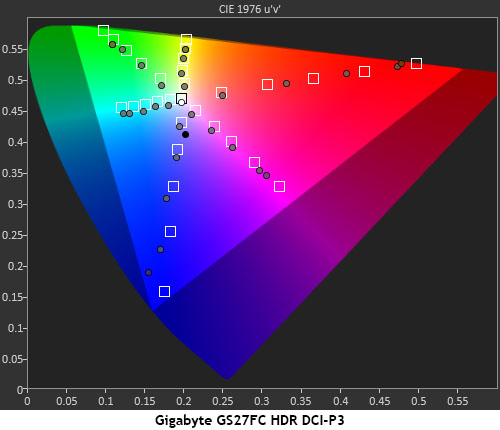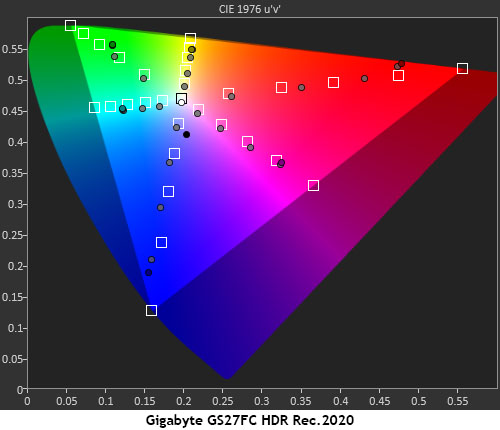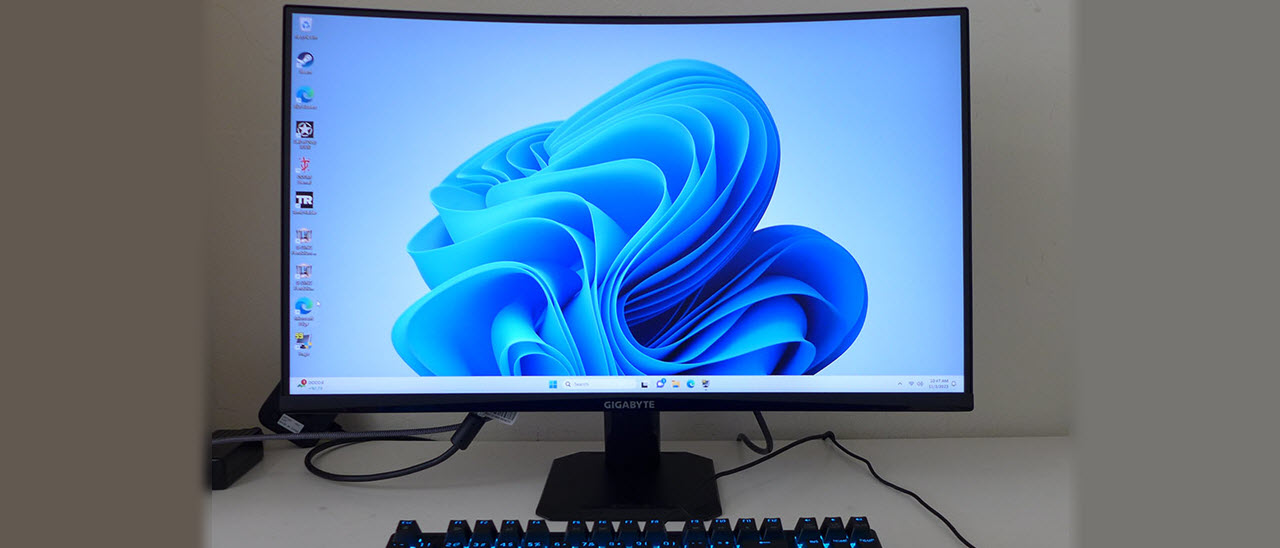Why you can trust Tom's Hardware
Our HDR benchmarking uses Portrait Displays’ Calman software. To learn about our HDR testing, see our breakdown of how we test PC monitors.
Budget gaming monitors like the GS27FC support HDR signals but don’t usually apply any dynamic contrast. With an edge backlight in play, that means HDR contrast will be about the same as SDR. You might get a little more punch, but if you want truly impactful HDR, a zone dimming, or OLED screen is necessary. Note that the Dell and Viotek are excluded from this comparison because they don’t support HDR.
HDR Brightness and Contrast



The GS27FC finds a bit more light output in HDR mode with 334 nits peak. This is lower than the other screens. But because black levels are the lowest of the bunch, it has the greatest dynamic range. When viewed together, the other screens will look a touch brighter, but the GS27FC will have deeper blacks and a more dimensional and textured image. The monitor with more contrast is always the one I’ll gravitate to.
Grayscale, EOTF and Color



The GS27FC switches automatically to HDR mode without user intervention. There are no picture adjustments available, but looking at the test results, none are necessary. Brighter gray steps are a tad cool in tone, but this is a small error. The EOTF tracks a little darkly up to the tone-map transition at 65%. This is forgivable because it gives HDR a tad more impact.
In the color test, the GS27FC is over-saturated at the inner red points, and then falls short of 100% saturation. This also gives HDR a bit more punch than SDR. Blue tracks its hues better than it does in SDR mode, but the max stimulus point is still off the mark. Rec.2020 mastered content will show the same behavior. Overall, HDR color looks natural with just a little less vibrance than a wide gamut screen.
Test Takeaway: The GS27FC is about as good as it gets among value-priced HDR monitors. There isn’t any dynamic contrast which is typical, so you get about the same 4,000:1 as SDR. But with a little more punch in color, there is a visible difference in actual content.
MORE: Best Gaming Monitors
Get Tom's Hardware's best news and in-depth reviews, straight to your inbox.
MORE: How We Test PC Monitors
MORE: How to Buy a PC Monitor
MORE: How to Choose the Best HDR Monitor

Christian Eberle is a Contributing Editor for Tom's Hardware US. He's a veteran reviewer of A/V equipment, specializing in monitors. Christian began his obsession with tech when he built his first PC in 1991, a 286 running DOS 3.0 at a blazing 12MHz. In 2006, he undertook training from the Imaging Science Foundation in video calibration and testing and thus started a passion for precise imaging that persists to this day. He is also a professional musician with a degree from the New England Conservatory as a classical bassoonist which he used to good effect as a performer with the West Point Army Band from 1987 to 2013. He enjoys watching movies and listening to high-end audio in his custom-built home theater and can be seen riding trails near his home on a race-ready ICE VTX recumbent trike. Christian enjoys the endless summer in Florida where he lives with his wife and Chihuahua and plays with orchestras around the state.
-
pug_s It doesn't look like a sale price. Last month I brought a Lenovo 27" FHD 165 refresh rate monitor for $100 from Microcenter but I ended up returning it when I brought an LG 34" 160hz 3440 x 1440 ultrawide for $200 instead.Reply -
ThomasKinsley Reply
I definitely agree. $180 for a FHD VA panel seems rather expensive, and 1080p at 27'' is noticeably blurry. 1440p is a big step up. You can even snag a 4k 60hz at that price.pug_s said:It doesn't look like a sale price. Last month I brought a Lenovo 27" FHD 165 refresh rate monitor for $100 from Microcenter but I ended up returning it when I brought an LG 34" 160hz 3440 x 1440 ultrawide for $200 instead. -
Order 66 I've said it before numerous times and I'll say it again, VA monitors generally have issues with motion rendering making it look like there is heavy motion blur. If there is a VA monitor that doesn't have these motion issues, I would maybe consider it, but right now, no.Reply -
kjfatl Can anyone actually tell the difference between a 120Hz and an 180Hz refresh rate? If anything, 180Hz might slow down the system response time due to the extra GPU and CPU cycles?Reply
I would like to see the results with a blind test of 'expert' gamers.
It is my understanding that the upper limit for human perception to a drastic change in light is about 200Hz. -
pug_s Reply
Depends on the person. A good number of people can tell the difference betwen 60hz and 120hz. But IMO, I doubt anybody could tell the difference anything 120hz and above.kjfatl said:Can anyone actually tell the difference between a 120Hz and an 180Hz refresh rate? If anything, 180Hz might slow down the system response time due to the extra GPU and CPU cycles?
I would like to see the results with a blind test of 'expert' gamers.
It is my understanding that the upper limit for human perception to a drastic change in light is about 200Hz.
